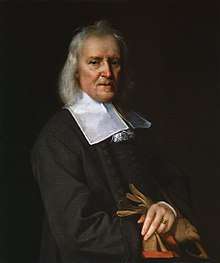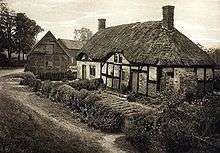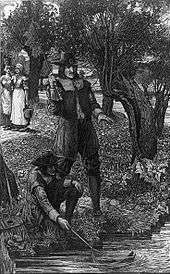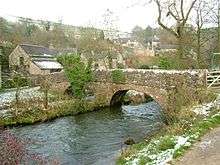Izaak Walton
Izaak Walton (c. 1593 – 15 December 1683) was an English writer. Best known as the author of The Compleat Angler, he also wrote a number of short biographies including one of his friend John Donne. They have been collected under the title of Walton's Lives.
Izaak Walton | |
|---|---|
 Portrait of Walton by Jacob Huysmans, c. 1672 | |
| Born | Izaak Walton c. 1593 Stafford, England |
| Died | 15 December 1683 (NS: 25 December 1683) Winchester, England |
Notable work | The Compleat Angler (1653) |
| Spouse(s) |
|

Biography
Walton was born at Stafford in c. 1593. The register of his baptism in September 1593 gives his father's name as Jervis, or Gervase. His father, who was an innkeeper as well as a landlord of a tavern, died before Izaak was three, being buried in February 1596/7[lower-alpha 1] as Jarvicus Walton. His mother then married another innkeeper by the name of Bourne, who later ran the Swan in Stafford.[1] Izaak also had a brother named Ambrose, as indicated by an entry in the parish register recording the burial in March 1595/6 of an Ambrosius filius Jervis Walton.
His date of birth is traditionally given as 9 August 1593. However, this date is based on a misinterpretation of his will, which he began on 9 August 1683.[2]
He is believed to have been educated in Stafford before moving to London in his teens. He is often described as an ironmonger, but he trained as a linen draper, a trade which came under the Ironmongers' Company.[3] He had a small shop in the upper storey of Thomas Gresham's Royal Burse or Exchange in Cornhill. In 1614 he had a shop in Fleet Street, two doors west of Chancery Lane in the parish of St Dunstan's.[4] He became verger and churchwarden of the church, and a friend of the vicar, John Donne.[2] He joined the Ironmongers' Company in November 1618.[2] Walton's first wife was Rachel Floud (married December 1626), a great-great-niece of Archbishop Cranmer. She died in 1640. He soon remarried, to Anne Ken (1646–1662), who appears as the pastoral Kenna of The Angler's Wish; she was a stepsister of Thomas Ken, afterwards bishop of Bath and Wells.[1]
After the Royalist defeat at Marston Moor in 1644, Walton retired from his trade. He went to live just north of his birthplace, at a spot between the town of Stafford and the town of Stone, where he had bought some land edged by a small river. His new land at Shallowford included a farm, and a parcel of land; however by 1650 he was living in Clerkenwell, London. Following the Restoration of the Monarchy it was revealed he had aided the Royalists, Izaak was a staunch Royalist supporter, and at great personal risk he managed to safeguard one of the Crown Jewels (referred to as the Little or Lesser George) following Charles II defeat at the battle of Worcester. Walton was entrusted with returning it to London from where it was smuggled out of the country to Charles II who was then in exile.[5]
The first edition of his book The Compleat Angler was published in 1653. His second wife died in 1662, and was buried in Worcester Cathedral, where there is a monument to her memory. One of his daughters married Dr Hawkins, a prebendary of Winchester.[1]
The last forty years of his life were spent visiting eminent clergymen and others who enjoyed fishing, compiling the biographies of people he liked, and collecting information for the Compleat Angler. After 1662 he found a home at Farnham Castle with George Morley, Bishop of Winchester, to whom he dedicated his Life of George Herbert and his biography of Richard Hooker. He sometimes visited Charles Cotton in his fishing house on the Dove.[1]
Walton died in his daughter's house at Winchester on 15 December 1683 and was buried in Winchester Cathedral.[1][6]
Extract of Walton's Will
Isaac Walton, by will, dated 9 August 1698, gave to the town or corporation of Stafford, in which he was born, a farm, situate at Halfhead (adjoining to Shallowford), in the parish of Chebsey, for the good and benefit of some of the said town, to bind out, yearly, two boys, the sons of honest and poor parents, to be apprentices to some tradesmen or handicraftmen, to the intent that the said boys might the better afterwards get their own living: And he also gave £5. yearly, out of the said rent, to some maid servant that should have attained the age of 21 years, or to some honest poor man's daughter, to be paid to her on her marriage; and this being done, his will was, that what rent should remain of the said farm and land, should be disposed of as follows; first, he gave 20s, yearly, to be spent by the mayor of Stafford, and that what money or rent should remain undisposed of, should be employed to buy coals for some poor people that should have most need thereof in the said town.
Walton's cottage at Shallowford

Walton left his property as described above at Shallowford in Staffordshire for the benefit of the poor of his native town. He had purchased Halfhead Farm there in May 1655. In doing this he was part of a more general retreat of Royalist gentlemen into the English countryside, in the aftermath of the English Civil War, a move summed up by his friend Charles Cotton's well-known poem "The Retirement" (first published in the 5th edition of Walton's Compleat Angler). The cost of Shallowford was £350, and the property included a farmhouse, a cottage, courtyard, garden and nine fields along which a river ran. Part of its attraction may have been that the River Meece, which he mentions in one of his poems, formed part of the boundary. The farm was let to tenants, and Walton kept the excellent fishing.[1]
The cottage is now a Walton Museum. The ground floor of the museum is set-out in period, with information boards covering Walton's life, his writings and the story of the Izaak Walton Cottage. Upstairs a collection of fishing related items is displayed, the earliest dating from the mid-eighteenth century, while a room is dedicated to his Lives and The Compleat Angler. The Izaak Walton Cottage and gardens are open to the public on Sunday afternoons during the summer.[7]
The Compleat Angler

woodcut by Louis Rhead

The Compleat Angler[8] was first published in 1653, but Walton continued to add to it for a quarter of a century. It is a celebration of the art and spirit of fishing in prose and verse; 6 verses were quoted from John Dennys's 1613 work The Secrets of Angling. It was dedicated to John Offley, his most honoured friend. There was a second edition in 1655, a third in 1661 (identical with that of 1664), a fourth in 1668 and a fifth in 1676. In this last edition the thirteen chapters of the original had grown to twenty-one, and a second part was added by his friend and brother angler Charles Cotton, who took up Venator where Walton had left him and completed his instruction in fly fishing and the making of flies.[1]
Walton did not profess to be an expert with a fishing fly; the fly fishing in his first edition was contributed by Thomas Barker, a retired cook and humorist, who produced a treatise of his own in 1659; but in the use of the live worm, the grasshopper and the frog "Piscator" himself could speak as a master. The famous passage about the frog, often misquoted as being about the worm—"use him as though you loved him, that is, harm him as little as you may possibly, that he may live the longer"—appears in the original edition. The additions made as the work grew did not affect the technical part alone; quotations, new turns of phrase, songs, poems and anecdotes were introduced as if the author, who wrote it as a recreation, had kept it constantly in his mind and talked it over point by point with his many friends. There were originally only two interlocutors in the opening scene, "Piscator" and "Viator"; but in the second edition, as if in answer to an objection that "Piscator" had it too much in his own way in praise of angling, he introduced the falconer, "Auceps," changed "Viator" into "Venator" and made the new companions each dilate on the joys of his favourite sport.[1]
The best-known old edition of the Angler is J. Major's (2nd ed., 1824). The book was edited by Andrew Lang in 1896, followed by many other editions.[1]
Walton's Lives
Walton also made significant contributions to seventeenth-century life-writing throughout his career. His leisurely labours as a biographer seem to have grown out of his devotion to angling. It was probably as an angler that he made the acquaintance of Sir Henry Wotton, but it is clear that Walton had more than a love of fishing and a humorous temper to recommend him to the friendship of the accomplished ambassador. At any rate, Wotton, who had intended to write the life of John Donne, and had already corresponded with Walton on the subject, left the task to him. Walton had already contributed an elegy to the 1633 edition of Donne's poems, and he completed and published the life, much to the satisfaction of the most learned critics, in 1640. Sir Henry Wotton dying in 1639, Walton undertook his life also; it was finished in 1642 and published in 1651 as a preface to the volume Reliquiae Wottonianae. His life of Hooker was published in 1665, and his biography of George Herbert in 1670, the latter coinciding with a collected edition of Walton's biographical writings, The Lives of Dr. John Donne, Sir Henry Wotton, Mr. Richard Hooker, Mr. George Herbert (1670, 1675). His life of Bishop Robert Sanderson appeared in 1678. All these subjects were endeared to the biographer by a certain gentleness of disposition and cheerful piety; three of them at least—Donne, Wotton and Herbert—were anglers. Walton studied these men's lives in detail, and provides many insights into their character.[9]
Other literary works
- Sir John Skeffington
- John Chalkhill
- Waltoniana – an 1878 collection of Walton's poems and prose fragments
Walton in literature
Walton has appeared in a number of works of literature, both non-fiction and fiction.
Non-fiction
- Charles Lamb, in his letter to Samuel Taylor Coleridge, recommends the Compleat Angler: "It breathes the very spirit of innocence, purity, and simplicity of the heart. There are many choice old verses interspersed in it; it would sweeten a man's temper at any time to read it; it would Christianise every discordant angry passion; pray make yourself acquainted with it."[10]
- Gilbert Ryle uses him in his 1949 book The Concept of Mind as an example of "'knowing how' before 'knowing that'"; in his collected essays he writes that "We certainly can, in respect of many practices, like fishing, cooking and reasoning, extract principles from their applications by people who know how to fish, cook and reason. Hence Isaak Walton, Mrs Beeton and Aristotle. But when we try to express these principles we find that they cannot easily be put in the indicative mood. They fall automatically into the imperative mood."[11]
- Zane Grey mentions him in a fishing passage in his 1903 book Betty Zane on page 84. "Alfred Clark said 'I never knew one (girl) who cared for fishing.'" "Betty Zane answered 'Now you behold one. I love dear old Izaak Walton. Of course you (Clark) have read his book?'"[12]
Other commemorations
Advertising mogul and land developer Barron Collier founded the Izaak Walton Fly Fishing Club in 1908 at his Useppa Island resort near Fort Myers, Florida. The Izaak Walton League is an American association formed in 1922 in Chicago, Illinois, to preserve fishing streams. Walton has been inducted into the American National Fresh Water Fishing Hall of Fame.[13] There is a forest preserve in Homewood, IL called the Izaak Walton Forest Preserve. There are two pubs in England named The Izaak Walton: one in the village of East Meon, Hampshire,[14] the other in Cresswell, Staffordshire.[15] In the county town of Stafford, there is now a statue of him placed in the town park, by the bank of the river. This route through the park was originally known as 'Izaak Walton Walk', there is also a street in the north part of Stafford named for him.
There is a creek named after him in Owatonna, Minnesota. There is also a pub in Norwich named 'The Compleat Angler'. The Compleat Angler Hotel in Bimini, Bahamas was destroyed by fire in 2006; the hotel bar was frequented by Ernest Hemingway. The Allen-Edmonds shoe company of Port Washington, Wisconsin produces a "Walton" style in tribute. In the Silver Divide region of the Sierra Nevada mountain range of California, a major peak is named after Izaak Walton. The Izaak Walton State Recreation Site in Sterling, Alaska is located at the confluence of the Moose River and the Kenai River,[16] and his name is lent to the historic Izaak Walton Inn in Montana. There is an Izaak Walton Inn in Embu, Kenya,[17] overlooking a small stream that feeds into the Rupingazi River.
Notes
- See dual dating.
References
- Chisholm, 1911.
- "Izaak Walton: The Compleat Anglican". The Collegiate Church of St Mary, Stafford. Archived from the original on 30 May 2014. Retrieved 24 June 2013.
- Jessica Martin, 'Walton, Izaak (1593–1683)', Oxford Dictionary of National Biography, Oxford University Press, 2004; online edn, May 2013 accessed 1 Jan 2017
- Reynolds, H. The Churches of the City of London. Bodley Head, 1922
- Poulton-Smith, A. Bloody British History. History Press, 2013
- "Izaak Walton: Biographer and angler". Winchester Cathedral. Retrieved 24 June 2013.
- "Izaak Walton's Cottage". Stafford Borough Council. Retrieved 24 June 2013.
- Walton, Izaak; Cotton, Charles (1897). The Compleat Angler. London and New York: John Lane: The Bodley Head.
- Encyclopædia Britannica (1911), pp. 300–01
- Lamb, Charles. Letter to Samuel Taylor Coleridge.
- Ryle, Gilbert (16 June 2009). Collected Essays 1929–1968: Collected Papers. Routledge. p. 231. ISBN 978-1-134-01208-4.
- Grey, Zane (1903). Betty Zane. New York: Grosset & Dunlop. p. 84.
- Danilov, Victor J. (1997). Hall of fame museums. Greenwood Publishing Group. p. 113. ISBN 0-313-30000-3.
National Fresh Water Fishing Hall of Fame.
- "Izaak Walton Public House". izaakwalton.biz. Retrieved 9 June 2015.
- "The Izaak Walton". izaakwaltoncresswell.com. Archived from the original on 1 August 2015. Retrieved 9 June 2015.
- http://www.alaska.org/detail/izaak-walton-state-recreation-site
- https://www.izaakwaltoninn.co.ke/
Sources
| Wikisource has the text of the 1885–1900 Dictionary of National Biography's article about Walton, Izaak. |

- Martin, Jessica (2004). "Walton, Izaak (1593–1683), author and biographer". Oxford Dictionary of National Biography. Oxford University Press.
Further reading
- Bottrall, Margaret (1955). Izaak Walton. Longmans, Green.
- Bussby, Frederick (1966). Izaak Walton. Friends of Winchester Cathedral.
- Chadwick, Owen (1984). The Fisherman and his God: Izaak Walton. Canine Press.
- Martin, Stapleton (1903). Izaak Walton and his Friends. Chapman and Hall.
- Pool, J. Lawrence; Pool, Angeline J. (1976). Izaak Walton: the compleat angler and his turbulent times. Stinehour Press.
- Stanwood, P. G. (1998). Izaak Walton. Prentice Hall.
External links
| Wikisource has original works written by or about: Izaak Walton |
| Wikiquote has quotations related to: Izaak Walton |
| Wikimedia Commons has media related to Izaak Walton. |
- Izaak Walton's Cottage (official Stafford Borough Council page)
- The Official Izaak Walton League of America Website
- BBC Local Heroes: Stoke & Staffordshire: Izaak Walton
- Works by Izaak Walton at Project Gutenberg
- Works by or about Izaak Walton at Internet Archive
- Works by Izaak Walton at LibriVox (public domain audiobooks)
